- Department of Crop Production and Engineering Projects, High Polytechnic School, University of Santiago de Compostela, Lugo, Spain
Yield-SAFE is a biophysical model to predict long-term production according to light and water availability in agricultural, forest, and agroforestry systems. The Yield-SAFE model should be calibrated and validated for the highest number of tree species and crops to be used as a management tool that takes into account climate change. This study aimed to calibrate and validate the Yield-SAFE model for Pinus radiata D. Don and sown pasture (Dactylis glomerata L.) to estimate the production in (1) forest systems, (2) agricultural systems, and (3) silvopastoral systems established in Galicia (NW Spain) under different conditions of climate: (i) reference “current” climate from 1961 to 1990, (ii) climate from 2021 to 2050, and (iii) climate from 2051 to 2080. The Yield-SAFE model can now be used to assess the long-term productivity of P. radiata D. Don and D. glomerata L. under different land uses and climate conditions. The Yield-SAFE model simulated similar tree and pasture growth in all scenarios of climate because the inter-annual variation of climate was small. However, tree growth estimated with the Yield-SAFE model was higher in the silvopastoral systems than in the forest systems, indicating that land use had more impact on land productivity than climate. Therefore, in regions such as Galicia, the Yield-SAFE model could be used as a tool to support the land use change in an agroforestry context, whilst also including climate scenarios which is considered a valuable solution to mitigate the effect of climate change.
Introduction
Climate change is one of the most important current environmental problems which affects the whole planet (National Oceanic and Atmospheric Administration [NOAA], 2022). To mitigate the climate change impact, at the Paris climate conference (COP21), 195 countries adopted an agreement to keep a global temperature rise this century well below 2°C and to drive efforts to limit the temperature increase even further to 1.5°C above pre-industrial levels. The Paris agreement was ratified during the last United Nations climate change conference (COP26) through actions that can get the world on a more sustainable and low-carbon pathway forward. Therefore, nowadays finding ecological and low-cost methods to combat climate change is one of the most important international policy goals. In this context, agroforestry systems, defined as the deliberate integration of woody vegetation with a lower-story agricultural production (Mosquera-Losada et al., 2018), were mentioned by several international organizations such as the IPCC (IPCC, 2019), FAO (Food and Agriculture Organization of the United Nations [FAO], 2019), or IPBES (IPBES, 2019) as a mechanism for mitigation and adaptation to climate change.
The key role of agroforestry systems in fighting against climate change was recently described in the Atlantic and Mediterranean areas of the planet (Ferreiro-Domínguez et al., 2022a,b). In those areas, agroforestry systems improve the resilience of agricultural systems to the effects of climate change due to their ability to retain and increase the sequestered carbon aboveground but also belowground where carbon is linked to the smallest soil aggregate fractions in the long-term. Agroforestry systems also provide other ecosystem services such as soil erosion reduction, water availability or biodiversity conservation. Therefore, the agroforestry systems implementation can help countries reach their goals related to climate change adaptation and mitigation but also the Sustainable Development Goals targets related to food and water security (United Nations [UN], 2015). For these reasons, in recent decades, modern agroforestry systems have been proposed at the European level as a land use alternative for conventional agricultural and forest systems. However, the environmental and productive benefits of agroforestry systems compared to conventional agricultural or forest systems are highly difficult to predict due to the interaction of multiple biophysical and management factors. Furthermore, research through field experiments is expensive and time-consuming when woody vegetation and crop measurements have to be taken into account (Poulton, 1995; Palma et al., 2007). One option to overcome these drawbacks could be the use of models such as the Yield-SAFE model (van der Werf et al., 2007). The Yield-SAFE is a biophysical model to predict long-term production according to the daily availability of light and water in agricultural and forest systems but also agroforestry systems (van der Werf et al., 2007). The effect of light and water availability on the productivity of agroforestry systems was also considered in other agroforestry models (Eagleson and Segarra, 1985; Charbonnier et al., 2013; Dupraz et al., 2019). Moreover, in the last years, the Yield-SAFE model has been further improved to provide the ability to model soil carbon dynamics, nitrogen leaching, and livestock production, considering the effect of the tree microclimate and the different scenarios of climate change established by the IPCC (Palma et al., 2016, 2018).
The Yield-SAFE model is already available for different tree species and crops (Graves et al., 2007; Palma et al., 2007). However, it is necessary to calibrate and validate the model for the highest possible number of tree species and crops to use the model at the European level as a management tool that takes into account resource use processes including climate change drivers. In this context, Pinus radiata D. Don (P. radiata) is an exotic conifer widely used in afforestation and reforestation in Spain, especially in the north, mainly due to its fast growth rate compared with other autochthonous tree species (Crecente-Campo et al., 2009). P. radiata is also one of the most widely used tree species in the establishment of silvopastoral systems (combining woody vegetation with forage and animal production) in regions such as Galicia (NW Spain) (Mosquera-Losada et al., 2015; Ferreiro-Domínguez et al., 2022b). In this region, P. radiata occupies an area of 96.177 ha according to the IV National Forest Inventory, around 7% of the total wooded area (Iv National Forest Inventory [NFI], 2011). Under this context, the calibration and validation of the Yield-SAFE model for this tree species is of high importance in Spanish regions such as Galicia where 69% of the land is forest land (Xunta de Galicia, 2016). The Yield-SAFE model could also be calibrated and validated for herbaceous species such as Dactylis glomerata L. (D. glomerata), which is widely used to establish sown pasture in open areas, but also in silvopastoral systems due to its shade tolerance (Peri et al., 2001). It is important to be aware that grasslands, including sown pasture and rangeland, are among the largest ecosystems in the world (Food and Agriculture Organization of the United Nations [FAO], 2016). Moreover, silvopasture is the most used agroforestry practice across Europe as it covers over 18 million hectares (4.27% of the EU territory and 25% of the land considered as grasslands), leaving around 75% of the EU grassland as potential areas where agroforestry practices can be implemented (Mosquera-Losada et al., 2018).
This study aimed to calibrate and validate the Yield-SAFE model for P. radiata and sown pasture (D. glomerata) to estimate the production in (1) forest systems, (2) agricultural systems, and (3) silvopastoral systems established in Galicia (NW Spain) under different conditions of climate: (i) reference “current” climate from 1961 to 1990, (ii) climate from 2021 to 2050, and (iii) climate from 2051 to 2080.
Materials and methods
Yield-SAFE model calibration
The Yield-SAFE calibration procedure was done, as a first step, for potential growth data of P. radiata (Sánchez et al., 2003) and D. glomerata (Yepes and Piñeiro, 1972) obtained from the measurement of permanent sample plots established in Galicia (NW Spain) without fertilization and irrigation. In both cases, the Yield-SAFE calibration for P. radiata and D. glomerata was done assuming light and temperature, but not water, limited growth within the model. With no water limiting conditions, potential growth is expected, and therefore a fine-tuning of parameters was made. However, the validation of the model and the successive simulations take into consideration the real water availability and water availability provided by the CliPick tool (Palma, 2017), respectively.
The calibration of model parameters for the potential growth of P. radiata and D. glomerata was based on an extensive literature review and existing datasets with tree and pasture measurements. Climate data (daily maximum and minimum temperature and daily precipitation) were taken from nearby weather stations to the study area where tree and pasture data were collected to validate the model (Galicia, NW Spain). In the case of the radiation and the relative humidity, the data was obtained through the CliPick tool (Palma, 2017) due to the lack of data in the weather stations. In CliPick, we used the highest resolution available (approx. 12 km) historical dataset of the Regional Atmospheric Climate Model (RACMO) developed by the Royal Netherlands Meteorological Institute (KNMI) and generated in the framework of the EURO-CORDEX effort which has shown a remarkable quality on the representation of European climate, in particular precipitation (Kotlarski et al., 2014; Katragkou et al., 2015; Prein et al., 2015).
In the case of the tree, parameter calibration of the Yield-SAFE model was made with a Python version of the model prepared to use an optimization module with the L-BFGS-B algorithm (Byrd et al., 1995). In this technique, lower and upper bounds were set for each parameter value found in the literature, and a minimization procedure was performed on the likelihood between observed vs. modeled, providing the optimal set of parameters that best fit the observed measurements. A MS Excel© implementation of the model was used to corroborate the tree calibration results and provide a graphic interpretation of the results (Graves et al., 2010). The MS Excel© implementation of the model was also used to carry out the pasture parameter calibration.
Yield-SAFE model validation
In a second step, the calibrated parameters of the Yield-SAFE model for the potential growth of P. radiata and D. glomerata were used to validate the model with observed data in long-term experiments established in Lugo (Galicia, NW Spain) at an altitude around 450 m above sea level.
In the case of the trees, the model was validated with the data of tree heights and diameters measured in a silvopastoral system established with P. radiata from 1995 to 2013. In that silvopastoral system, the density of the plantation was 833 trees ha–1 with a planting distance of 3 m × 4 m. After plantation, the understory was sown with a mixture of D. glomerata var. Saborto (25 kg ha–1), Trifolium repens L. var. Ladino (4 kg ha–1) and Trifolium pratense L. var. Marino (1 kg ha–1). Fertilizers were not applied to replicate traditional reforestation practices for agricultural land in this area. Moreover, low pruning was performed on trees at the end of 2001. Tree biomass was also determined with a robust allometric equation based on the tree height and diameter. This allometric equation was developed by Montero et al. (2005) and used for parameter validation of the model. It is important to be aware that the tree biomass was considered as estimated data and therefore its standard deviation was increased by 70% when calculating likelihood.
The validation of pasture parameters of the Yield-SAFE model was performed with pasture production data from an agricultural plot sown with a mixture of D. glomerata var. Artabro (25 kg ha–1) and Trifolium repens L. var. Huia (3 kg ha–1) without fertilization. This plot was selected to validate the parameters of the model due to the high proportion of D. glomerata in the botanic composition of the pasture (above 80% in almost all harvests) because the Yield-SAFE model is not yet prepared to work with a multispecific pasture composition with different light and humidity requirements. For parameter validation of the Yield-SAFE model, the pasture production (Mg dry matter ha–1) estimated in May, June, July, and December from 1999 to 2006 was considered. Annual pasture production was also calculated by summing the consecutive harvests of the pasture production in that year and was used to validate the model.
Modeling scenarios
Once the Yield-SAFE model was calibrated and validated, the model was used to determine the productivity of hypothetical land uses: (i) forest systems established with P. radiata in which the forest management of the yield tables for this tree species in Galicia was simulated (Sánchez et al., 2003), (ii) agricultural systems with pasture (D. glomerata), (iii) silvopastoral systems in which the pasture production was combined with the growth of P. radiata established at 100 trees ha–1 to keep the land eligible for the Common Agricultural Policy (CAP) support [article 9 of the Commission Delegated Regulation 640/2014 (European Union [EU], 2014)].
Moreover, the production obtained in these hypothetical land uses was compared in different scenarios of climate from KNMI-RACMO datasets provided by the CliPick tool (Palma, 2017): (i) climate from 1961 to 1990 representing the current climate, (ii) climate from 2021 to 2050 simulated with the Representative Concentration Pathway 8.5 (RCP 8.5) scenario, and (iii) climate from 2051 to 2080 simulated with the RCP 8.5.
Results
Calibration and validation of the Yield-SAFE model
Tree
The tree growth calibration process delivered a set of parameters (Table 1) which is bounded within the parameters found in the literature. The consistency of the model in estimating the tree growth with those parameters can be observed in Figure 1A in the case of the potential tree growth (calibration) and Figure 1B for the observed data (validation). In year 30 of the calibration process, the Yield-SAFE model reached values of 26.82 m for height, 43.02 cm for diameter, 1.61 m3 tree–1 for tree volume, 362.8 m3 ha–1 for stand volume, and 992 kg tree–1 for biomass. While the values reached by the Yield-SAFE model in the validation process in the year 18 were 20.82 m for height, 31.62 cm for diameter, 0.68 m3 tree–1 for tree volume, 375.21 m3 ha–1 for stand volume, and 416 kg tree–1 for biomass. In both cases, these values were similar to the values of potential tree growth in the studied area and the observed data.
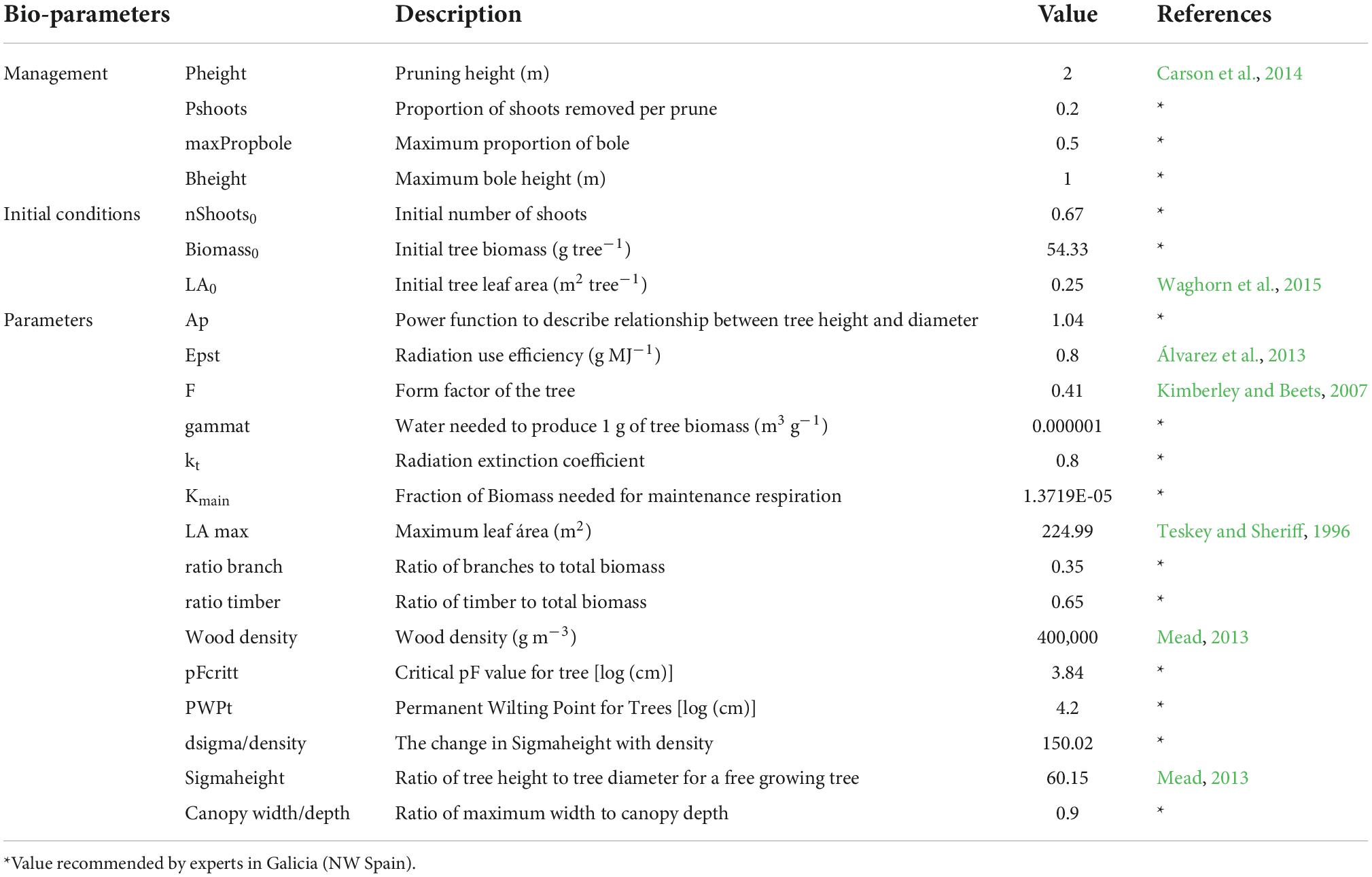
Table 1. Tree parameters used in the calibration and validation of the Yield-SAFE model for Pinus radiata.
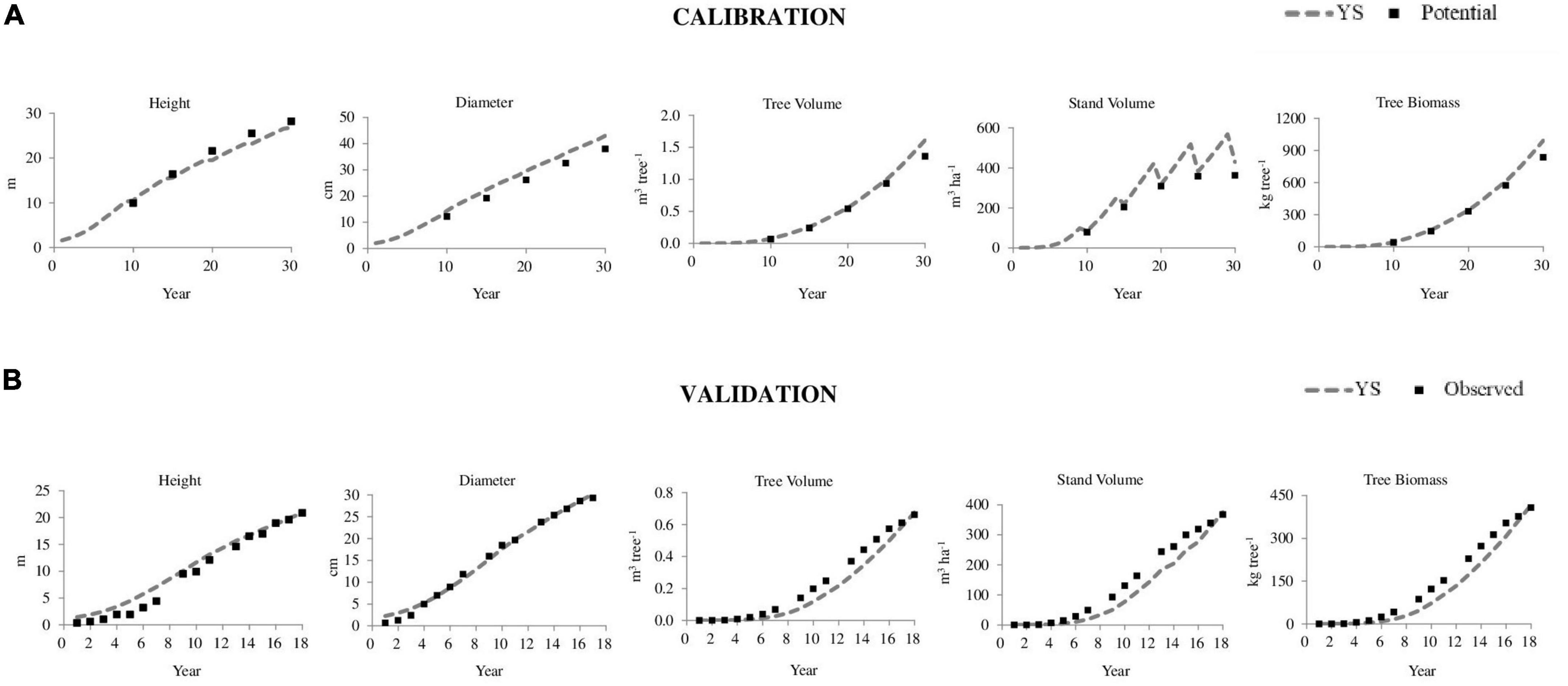
Figure 1. Results of the calibration (A) and validation (B) of the Yield-SAFE (YS) model for Pinus radiata in Galicia (NW Spain).
Pasture
The parameters for D. glomerata resulting from the calibration process of the Yield-SAFE model can be observed in Table 2. The Yield-SAFE model, set with the parameters of Table 2, captured the potential values of the annual production of D. glomerata in the area (10 mg dry matter ha–1) during the calibration process (Figure 2A). In the validation process, the Yield-SAFE model also reached the annual and seasonal values of pasture production in the majority of the dates (Figure 2B) providing a basis to predict the pasture response to different situations.
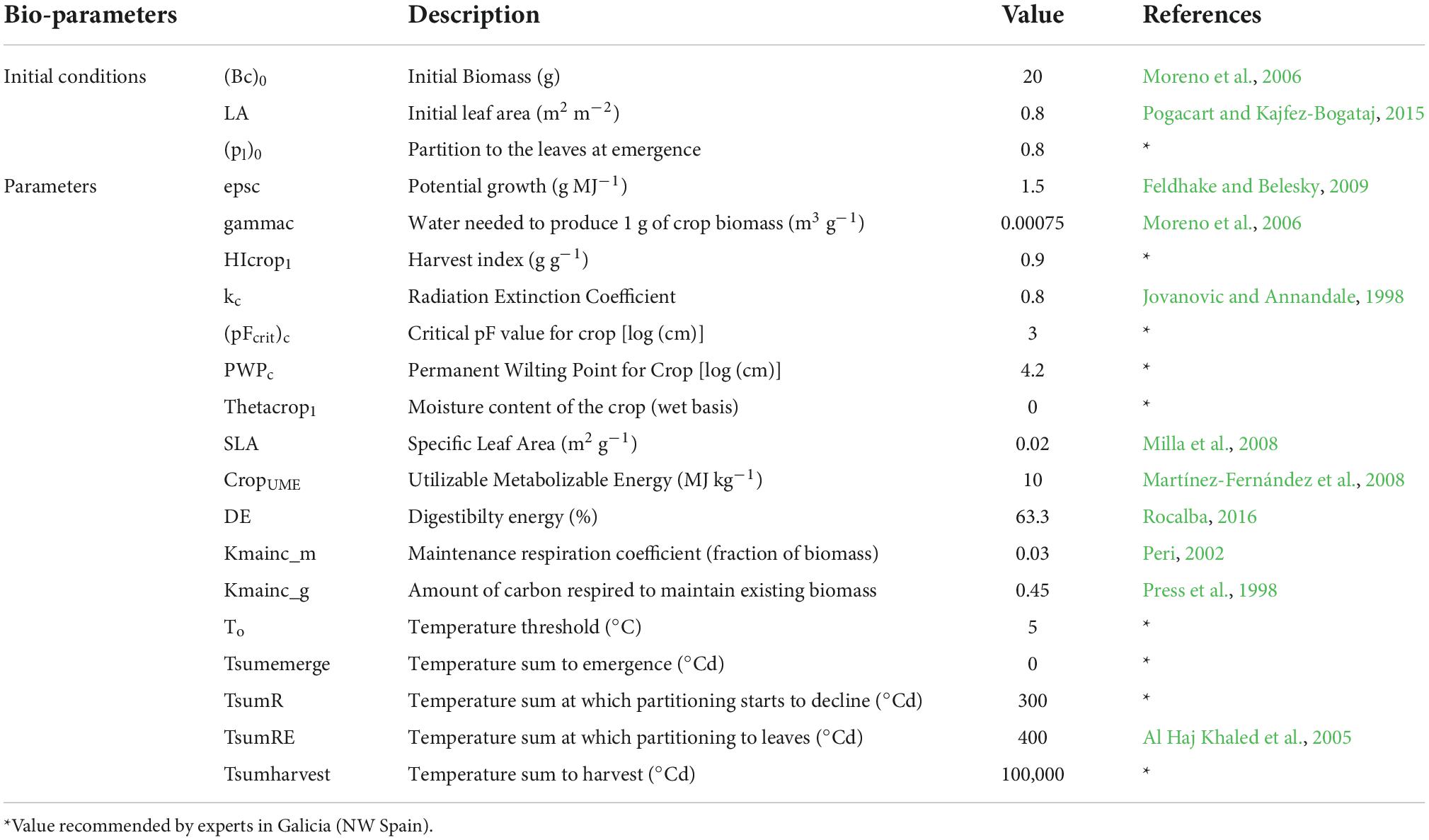
Table 2. Pasture parameters (Dactylis Glomerata) used in the calibration and validation of the Yield-SAFE model.
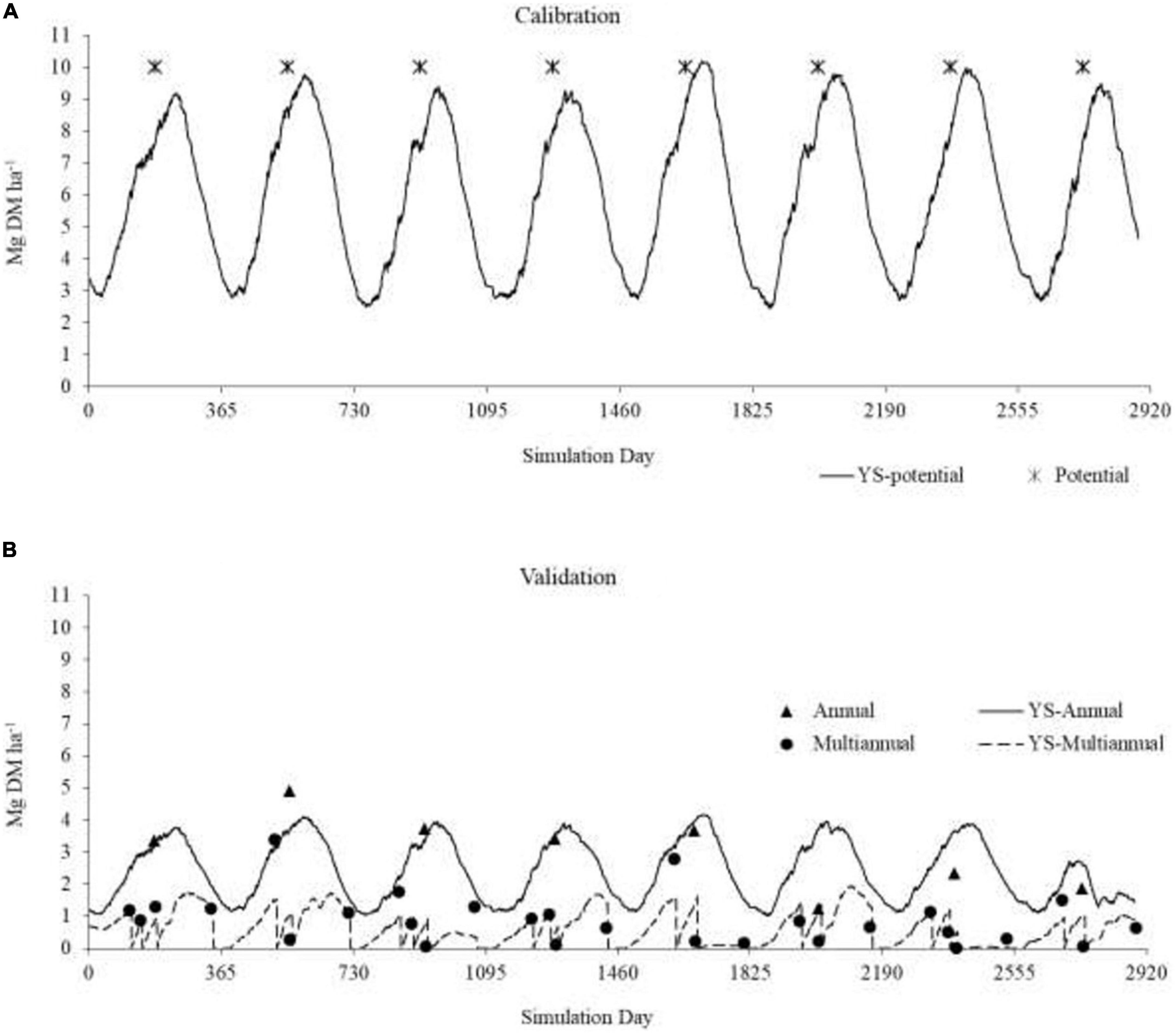
Figure 2. Results of the calibration (A) and validation (B) of the Yield-SAFE (YS) model for the pasture production (Dactylis glomerata) [Mg dry matter (DM) ha– 1] in Galicia (NW Spain).
Modeling scenarios
Climate
The annual data of precipitation and mean temperature estimated through the CliPick tool for the climate scenarios 1961–1990, 2021–2050, and 2051–2080 can be observed in Figure 3. The 2021–2050 scenario was the rainiest scenario with an annual mean precipitation of 1150.47 mm followed by the 2051–2080 scenario (1097.97 mm) and the 1961–1990 scenario (1014.4 mm). The 2021–2050 scenario had the lowest annual mean temperature (10.75). The highest annual mean temperature was present in the 2051–2080 scenario (11.72°C), being this temperature also slightly higher than that observed in the 1961–1990 scenario (11.37°C).
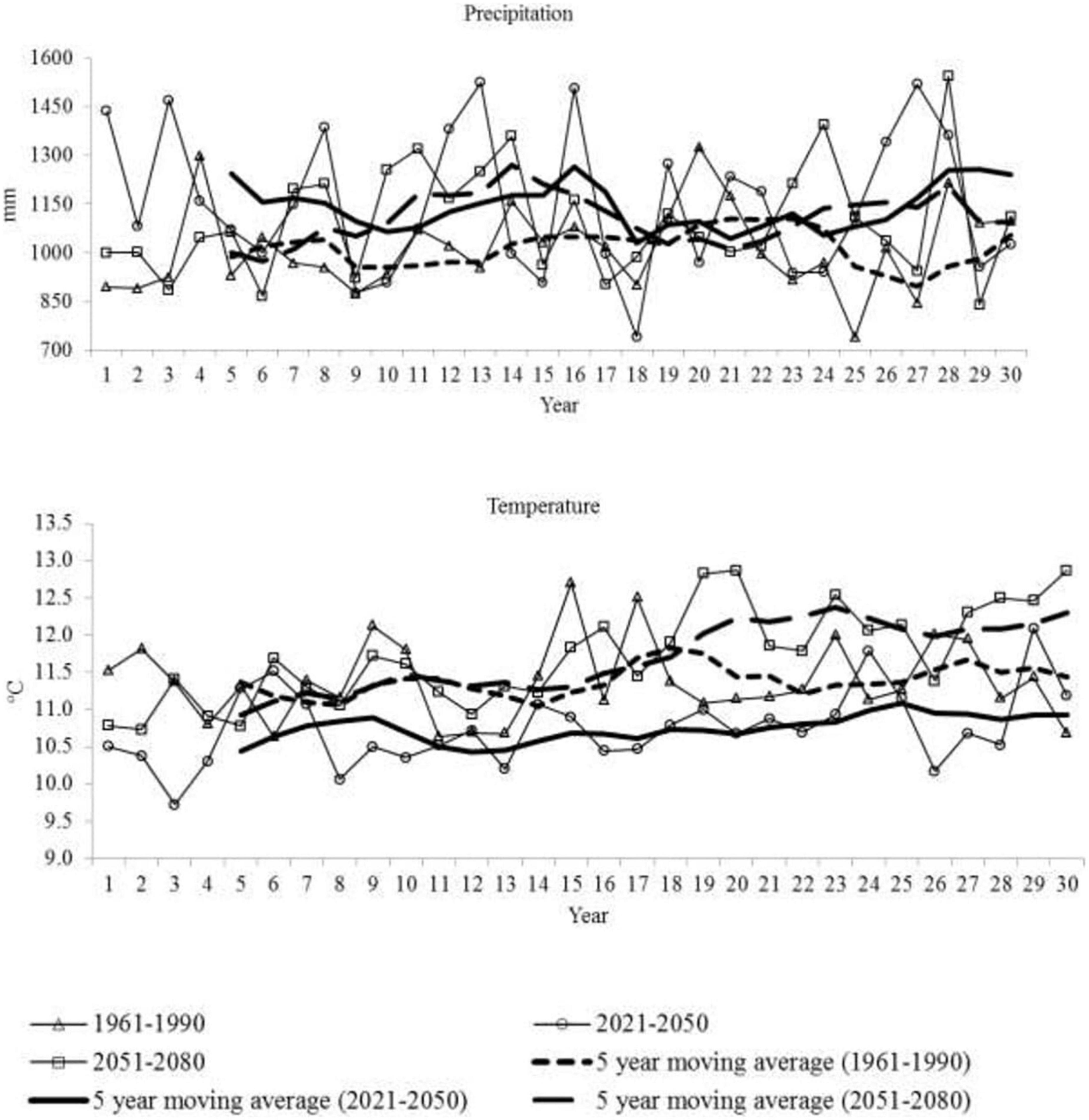
Figure 3. Annual precipitation (mm) and annual mean temperature (°C) simulated with the CliPick tool (Palma, 2017) for the scenarios of climate 1961–1990, 2021–2050, and 2051–2080.
Tree
Figure 4 shows that in the last years of the simulations, the height, diameter, volume, and biomass of the trees were higher in the hypothetical silvopastoral systems than in the hypothetical forest systems established in the same period. Thus, in the hypothetical silvopastoral systems, the height, diameter, volume, and biomass of the trees reached mean values of 30.20 ± 0.10 m, 50.14 ± 0.17 cm, 2.5 ± 0.02 m3 tree–1, and 1378.52 ± 29.34 kg tree–1, respectively, in the year 30. However, in the hypothetical forest systems, the Yield-SAFE model estimated a mean height of 26.66 ± 0.15 m, a mean diameter of 41.66 ± 0.23 cm, a mean volume of 2.16 ± 0.03 m3 tree–1, and a mean biomass of 850.67 ± 15.77 kg tree–1 in the year 30. Moreover, due to higher tree density, the stand volume increased in the forest systems (577 ± 9.62 m3 ha–1 in the year 30) compared to the silvopastoral systems (246.61 ± 2.49 m3 ha–1 in the year 30).
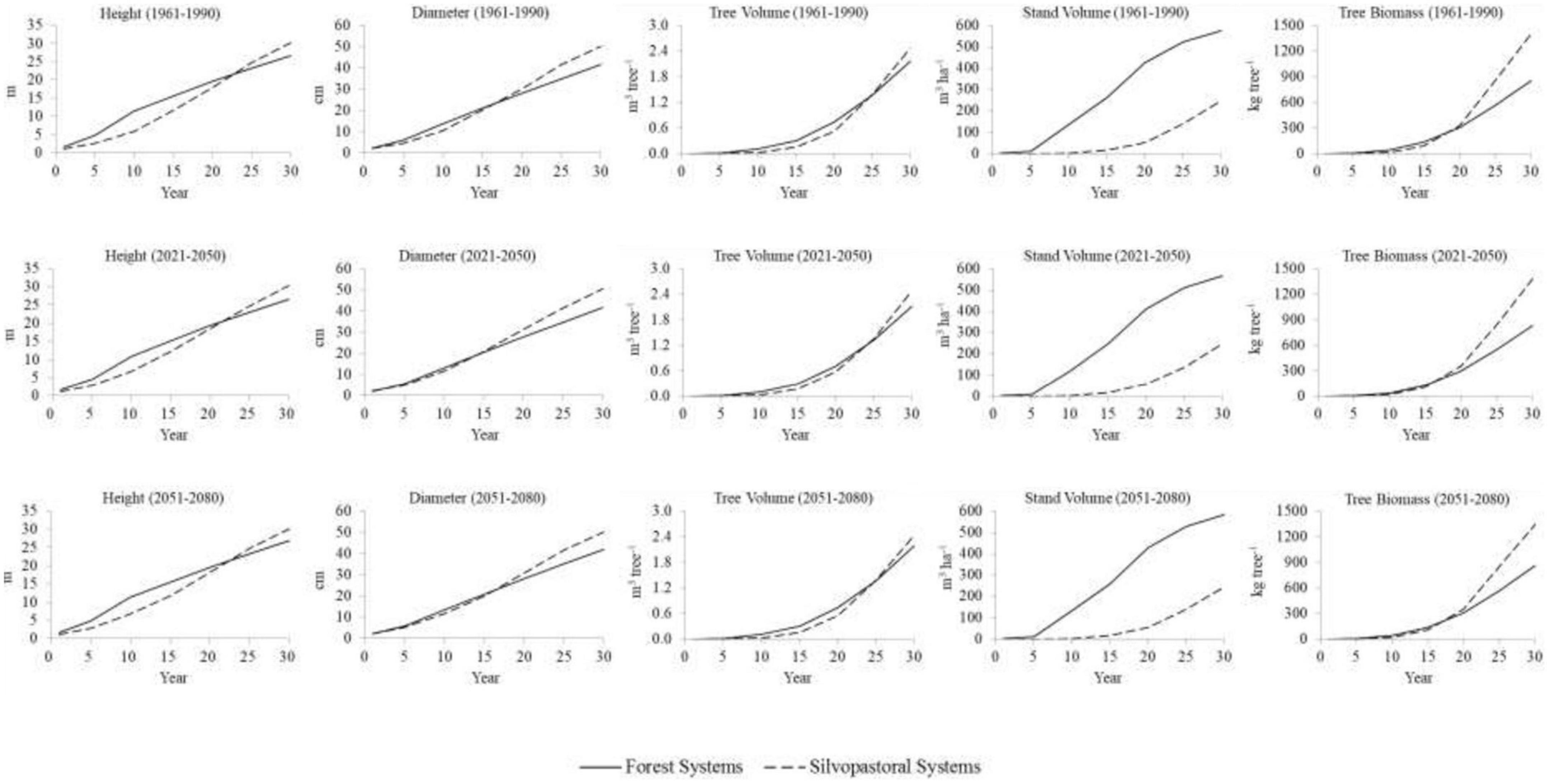
Figure 4. Growth of Pinus radiata simulated with the Yield-SAFE model in hypothetical forest and silvopastoral systems under different scenarios of climate established through the CliPick tool (Palma, 2017): (i) climate from 1961 to 1990, (ii) climate from 2021 to 2050, and (iii) climate from 2051 to 2080.
In the hypothetical forest and silvopastoral systems, the tree variables estimated with the Yield-SAFE model were generally similar in all climate scenarios with slightly lower tree growth in the 2021–2050 scenario (566.89 m3 ha–1 in the year 30) compared to the other climate scenarios (1961–1990 scenario: 578.08 m3 ha–1 and 2051–2080 scenario: 586.05 m3 ha–1 in the year 30) in the case of the forest systems.
Pasture
When the hypothetical agricultural systems were compared to the hypothetical silvopastoral systems established in the same period, the simulations showed that from year 10, there was a higher pasture production in the agricultural systems compared to the silvopastoral systems in all climate scenarios (Figure 5).
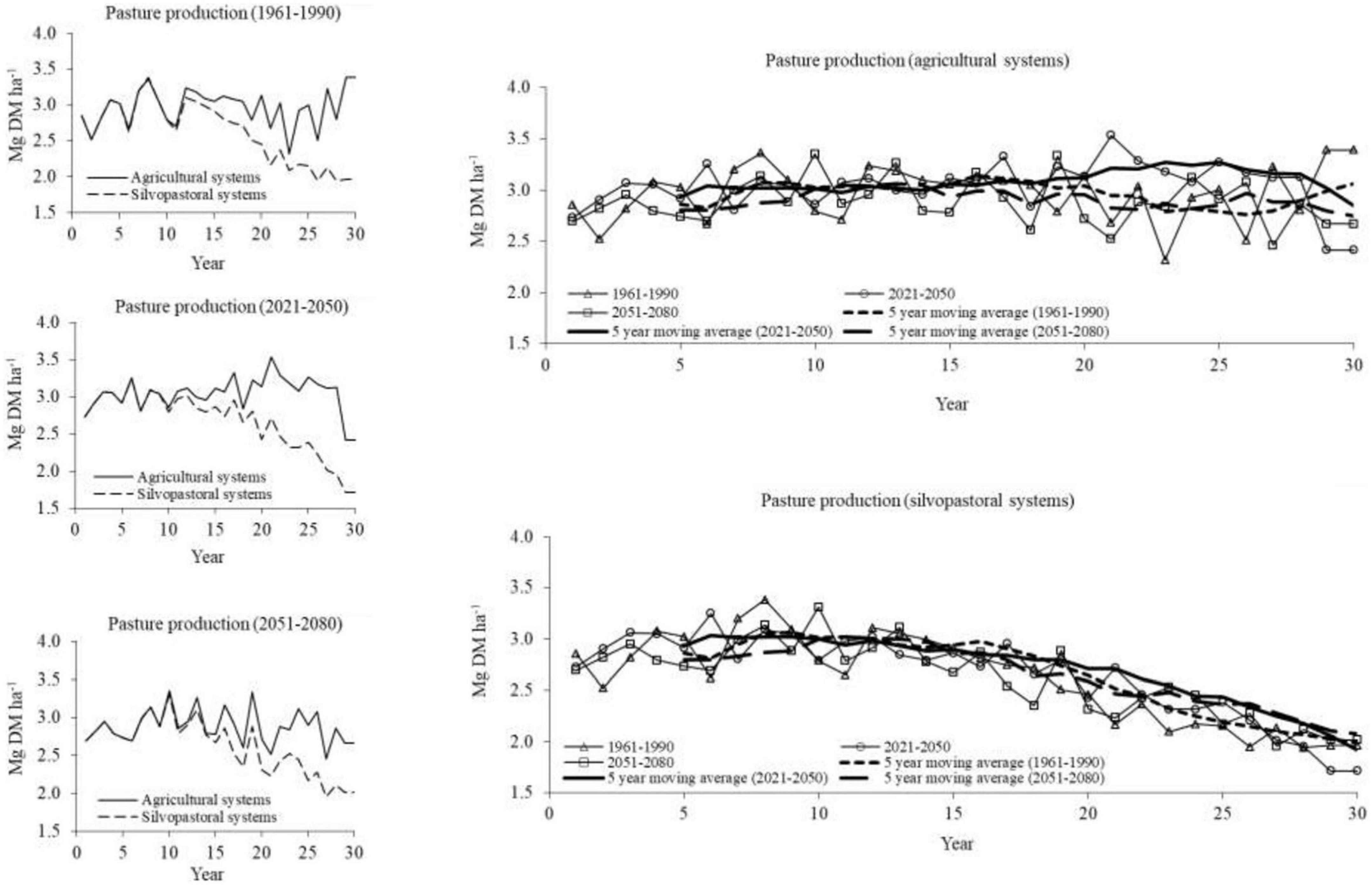
Figure 5. Pasture production (Dactylis glomerata) [mg dry matter (DM) ha– 1] simulated with the Yield-SAFE model in hypothetical agricultural and silvopastoral systems under different scenarios of climate established through the CliPick tool (Palma, 2017): (i) climate from 1961 to 1990, (ii) climate from 2021 to 2050, and (iii) climate from 2051 to 2080.
In the hypothetical agricultural systems, the mean values of pasture production estimated with the Yield-SAFE model were generally higher in the 2021–2050 scenario (3.04 ± 0.24 mg dry matter ha–1) compared to the 1961–1990 scenario (2.97 ± 0.26 mg dry matter ha–1) and the 2051–2080 scenario (2.88 ± 0.22 mg dry matter ha–1). This result was also observed in the hypothetical silvopastoral systems except for the last 5 years in which it seems that the mean values of production of pasture simulated with the Yield-SAFE model were higher in the 2051–2080 scenario (2.08 ± 0.13 mg dry matter ha–1) than in the 1961–1990 scenario (1.99 ± 0.08 mg dry matter ha–1) and the 2021–2050 scenario (1.92 ± 0.08 mg dry matter ha–1).
Discussion
Calibration and validation of the Yield-SAFE model
The Yield-SAFE model calibration and validation procedure was successfully performed for P. radiata. In this context, the model estimated in the hypothetical silvopastoral systems established tree yields of 2.5 m3 tree–1 at 30 years compared to forest systems (2.16 m3 tree–1). These values may seem too high at first sight. However, some authors as Mead (2013) report yields of about 3–4 m3 tree–1 in low-density systems in New Zealand. Regarding the pasture production, the results of the calibration and validation procedure show that on some dates, the Yield-SAFE model did not adequately reach the potential and observed production values. This behavior of the model could be due to the increase of the spontaneous species proportion in the pasture on these dates with different light and humidity requirements and cut responses than D. glomerata, however, it is important to be aware that the pasture production simulated by the model in the hypothetical agricultural and silvopastoral systems established in this study is within the ranges of 0.11–5.48 mg DM ha–1 and 1.57–7.72 mg DM ha–1 found by Rigueiro-Rodríguez et al. (2012) and Ferreiro-Domínguez et al. (2014), respectively, both in silvopastoral systems established in the same area with the same forest specie. Therefore, as shown below, in edaphoclimatic conditions similar to those of Galicia, the Yield-SAFE model could be used as a management tool to estimate the productivity in different land uses with tree species such as P. radiata and herbaceous species used to establish pastures such as D. glomerata Moreover, the Yield-SAFE model has already been successfully calibrated and validated for other tree species and crops established in the Atlantic and Mediterranean areas of Europe (Graves et al., 2010) which favors the use of the model at a high level under different climatic conditions.
Land use scenarios
When the tree growth in the hypothetical forest systems was compared to the tree growth in the hypothetical silvopastoral systems established in the same period (1961–1990, 2021–2050, and 2051–2080) it was found that in the last years, the height, the diameter, the volume and the biomass of the trees estimated with the Yield-SAFE model were higher in the silvopastoral systems than in the forest systems. The highest tree growth associated with the silvopastoral systems could be explained by the higher tree density in the forest systems than in the silvopastoral systems which could imply a high competition from neighboring trees in the forest systems, thereby reducing the tree growth over time (Woodruff et al., 2002). The higher tree density in the forest systems than in the silvopastoral systems also explains the higher stand volume found in the forest systems than in the silvopastoral systems.
In the case of pasture production, the Yield-SAFE model estimated that during the first 10 years, the pasture production was the same in the silvopastoral systems compared to the agricultural systems established in the same period probably due to the low size of the trees. However, from the tenth year, the Yield-SAFE model simulated a higher pasture production in the agricultural systems compared to the silvopastoral systems. This result could be explained by the light and water competition by the trees in the silvopastoral systems which can limit pasture development. It is important to be aware that in the Atlantic region of interest to this study, shade coverage greater than 55% reduces pasture production and quality between 30 and 50% (Rigueiro-Rodríguez et al., 2007) which is in line with the Yield-SAFE projections. The negative effect of tree growth on pasture production was also observed by Rigueiro-Rodríguez et al. (2012) in silvopastoral systems established in the same area with P. radiata and Betula alba L. These authors noted that the negative effect of P. radiata on pasture production was more important than that created by B. alba L. due to the faster growth rate and the denser aerial structure type of P. radiata which limits the amount of light reaching the understorey (Brockerhoff et al., 2001). Therefore, it is important to identify and apply optimal management practices to optimize tree growth and pasture production in conventional forest and agricultural systems but also in silvopastoral systems. The Yield-SAFE model could be used as a tool to carry out adequate land management under different scenarios that optimize land use productivity in an agroforestry context.
Climate scenarios
In this study, the results obtained showed that the tree and pasture growth was similar in all the scenarios of climate, independently of the land use, probably because the climate scenarios established by the IPCC simulate very small interannual variations of climatic conditions in the Galician region. This result suggests that land use has more impact on tree growth (and stand biomass/volume) than climate concerning productivity. However, it also seems that in the hypothetical forest systems, the tree variables simulated with the Yield-SAFE model were slightly lower in the 2021–2050 scenario compared to the other scenarios. This result could be explained by the lower annual mean temperature estimated in the 2021–2050 scenario (10.75°C) than in the 1961–1990 scenario (11.37°C), and the 2051–2080 scenario (11.72°C). In this context, the variation of the P. radiata growth due to temperature fluctuations was previously observed by Rook and Whitehead (1979) in different regions of New Zealand. These authors found that the difference of a few degrees in seasonal temperatures is a key factor in the variation of the P. radiata growth which agrees with the results simulated by the Yield-SAFE model in this study. However, it is important to take into account that as the climate is continually changing it is difficult to relate the response of tree growth to a single environmental variable. On the other hand, the improvement of P. radiata growth associated with an increase in temperatures could be considered beneficial. However, this means that trees need more water to keep growing throughout the season or they will stop growing due to water limitations while increasing wildfire risk. Once the growing season ends, the milder winters fail to kill dormant insects, increasing the risk of pests in subsequent seasons (Robinet and Roques, 2010). The increase in fire risk in the regions like Galicia would be a serious problem because Galicia is one of the most fire-prone areas in Europe (Joint Research Centre [JRC], 2017). Therefore, it is necessary to look for practices of mitigation and adaptation to climate change which decrease the forest fire risk such as silvopasture (Mosquera-Losada et al., 2018).
Although in the hypothetical forest systems of this study the Yield-SAFE model simulated a lower tree growth in the 2021–2050 scenario than in the other climate scenarios, the pasture production simulated by the model in the agricultural systems and the silvopastoral systems tended to increase in the 2021–2050 scenario compared to the other climate scenarios. The highest pasture production associated with the 2021–2050 scenario could be due to the higher precipitation registered in this scenario compared to the other scenarios. The positive relationship found between pasture production and annual precipitation was previously described by several authors as Smit et al. (2008) in different regions across Europe. However, it is necessary to highlight that in the 2021–2050 scenario, the tree growth was not positively affected by the increase of precipitation as the pasture probably because the model considers that the trees are less sensitive to lack of water [higher values for critical soil pF (soil water tension)] than the pasture. Finally, in the last 5 years of the hypothetical silvopastoral systems simulation, there was a higher pasture production in the 2051–2080 scenario than in the other scenarios. This result could be explained by the increase in the temperature (through the increase in the number of growing days) and by the lower soil water evaporation due to the presence of the trees.
Conclusion
The Yield-SAFE model has been used successfully in the last decade to estimate yields in agroforestry systems in the long term and that consistency is achieved in this study focused on the evaluation of the long-term productivity of P. radiata and D. glomerata Either in the forest, agricultural or agroforestry scenarios, the simulations of tree, and pasture growth were similar in all climate scenarios, probably because the inter-annual variation of climate conditions was relatively small.
The tree growth on a per-tree basis estimated with the Yield-SAFE model was higher in the silvopastoral systems than in the forest systems. Although this is a typical tree characteristic in agroforestry systems showing that resources are allocated to trees and stand biomass is not a linear reduction of tree density, this study also evidences that land use has more impact on land productivity than climate.
Nevertheless, the Yield-SAFE model is showing that can be used as a tool to support further assessments with other combinations of tree densities to find the management alternatives that optimize the land use productivity under an agroforestry context, whilst including climate scenarios. Although the latter may seem to have little effect mostly because the region has high precipitation rates (over 1,000 mm year–1), other climate scenarios may arrive due to different models or future projections with different CO2 concentration pathways.
In any case, modeling with the Yield-SAFE model seems to be a promising approach to assess agroforestry scenarios in Galicia, contributing to estimate the productivity of a land use system which is considered a valuable solution to mitigate the effect of climate change.
Data availability statement
The original contributions presented in this study are included in the article/supplementary material, further inquiries can be directed to the corresponding author.
Author contributions
MM-L: supervision. NF-D: writing—original draft. AR-R: writing—review and editing. All authors have read and agreed to the published version of the manuscript.
Funding
This work was funded by Xunta de Galicia, Consellería de Educación, Universidade e Formación Profesional through the Programa de Axudas á Etapa Posdoutoral Modalide A (DOG n° 122, 29/06/2016 p. 27443, exp: ED481B 2016/0710) and B (DOG n° 213, 08/11/2019 p. 48018, exp: ED481D 2019/009). NF-D was also funded by the Pilot Program of the University of Santiago de Compostela (USC) for the hiring of distinguished research staff—call 2021, funded under the collaboration agreement between USC and Banco Santander, for the years 2021–2024.
Acknowledgments
We would like to thank Divina Vázquez-Varela, Pablo Fernández-Paradela, Teresa Piñeiro-López, and Manuel Cotado-Rodríguez for their help with field and laboratory work.
Conflict of interest
The authors declare that the research was conducted in the absence of any commercial or financial relationships that could be construed as a potential conflict of interest.
Publisher’s note
All claims expressed in this article are solely those of the authors and do not necessarily represent those of their affiliated organizations, or those of the publisher, the editors and the reviewers. Any product that may be evaluated in this article, or claim that may be made by its manufacturer, is not guaranteed or endorsed by the publisher.
References
Al Haj Khaled, R., Duru, M., Theau, J. P., Plantureux, S., and Cruz, P. (2005). Variation in leaf traits through seasons and N-availability levels and its consequences for ranking grassland species. J. Veg. Sci. 16, 391–398. doi: 10.1111/j.1654-1103.2005.tb02378.x
Álvarez, J., Allen, H. L., Albaugh, T. J., Stape, J. L., Bullock, B. P., and Song, C. (2013). Factors influencing the growth of radiata pine plantations in Chile. Forestry 86, 13–26. doi: 10.1093/forestry/cps072
Brockerhoff, E. G., Ecroyd, C. E., and Langer, E. R. (2001). Biodiversity in New Zealand plantation forests: policy trends, incentives, and the state of our knowledge. N. Z. J. For. 46, 31–37.
Byrd, R. H., Lu, P., and Nocedal, J. (1995). A limited memory algorithm for bound constrained optimization. SIAM J. Sci. Stat. Comput. 16, 1190–1208. doi: 10.1137/0916069
Carson, S. D., Cown, D. J., McKinley, R. B., and Moore, J. R. (2014). Effects of site, silviculture and seed lot on wood density and estimated wood stiffness in radiata pine at mid-rotation. N. Z. J. For. Sci. 44, 1–12. doi: 10.1186/s40490-014-0026-3
Charbonnier, F., le Maire, G., Dreyer, E., Casanoves, F., Christina, M., Dauzat, J., et al. (2013). Competition for light in heterogeneous canopies: application of MAESTRA to a coffee (Coffea arabica L.) agroforestry system. Agric. For. Meteorol. 181, 152–169. doi: 10.1016/j.agrformet.2013.07.010
Crecente-Campo, F., Marshall, P., LeMay, V., and Dieguez-Aranda, U. (2009). A crown profile model for Pinus radiata D. Don in northwestern Spain. For. Ecol. Manag. 257, 2370–2379. doi: 10.1016/j.foreco.2009.03.038
Dupraz, C., Wolz, K. J., Lecomte, I., Talbot, G., Vincent, G., Mulia, R., et al. (2019). Hi-sAFe: a 3D agroforestry model for integrating dynamic tree–crop interactions. Sustainability 11:2293. doi: 10.3390/su11082293
Eagleson, P. S., and Segarra, R. I. (1985). Water-limited equilibrium of savanna vegetation systems. Water Resour. Res. 21, 1483–1493. doi: 10.1029/WR021i010p01483
European Union [EU] (2014). Comission Delegated Regulation (EU) No 640/2014 of 11 March 2014 Supplementing Regulation (EU) No 1306/2013 of the European Parliament and of the Council with Regard to the Integrated Administration and Control System and Conditions for Refusal or Withdrawal of Payments and Administrative Penalties Applicable to Direct Payments, Rural Development Support and Cross Compliance. Available online at: http://eur-lex.europa.eu/eli/reg_del/2014/640/oj (accessed June 15, 2022).
Feldhake, C. M., and Belesky, D. P. (2009). Photosynthetically active radiation use efficiency of Dactylis glomerata and Schedonorus phoenix along a hardwood tree-induced light gradient. Agro. For. Syst. 75, 189–196. doi: 10.1007/s10457-008-9175-9
Ferreiro-Domínguez, N., Palma, J. H. N., Paulo, J. A., Rigueiro-Rodríguez, A., and Mosquera-Losada, M. R. (2022a). Assessment of soil carbon storage in three land use types of a semi-arid ecosystem in South Portugal. Catena 213:106196. doi: 10.1016/j.catena.2022.106196
Ferreiro-Domínguez, N., Rodríguez-Rigueiro, F. J., Rigueiro-Rodríguez, A., González-Hernández, M. P., and Mosquera-Losada, M. R. (2022b). Climate change and silvopasture: the potential of the treeand weather to modify soil carbon balance. Sustainability 14:4270. doi: 10.3390/su14074270
Ferreiro-Domínguez, N., Rigueiro-Rodríguez, A., Bianchetto, E., and Mosquera-Losada, M. R. (2014). Effect of lime and sewage sludge fertilisation on tree and understory interactionin a silvopastoral system. Agric. Ecosyst. Environ. 188, 72–79. doi: 10.1016/j.agee.2014.02.007
Food and Agriculture Organization of the United Nations [FAO] (2016). Are Grasslands Under Threat? Brief Analysis of FAO Statistical Data on Pasture and Fodder Crops. Rome: FAO.
Food and Agriculture Organization of the United Nations [FAO] (2019). “The State of the world’s biodiversity for food and agriculture,” in FAO Commission on Genetic Resources for Food and Agriculture Assessments, eds J. Bélanger and D. Pilling (Rome: FAO).
Graves, A. R., Burgess, P. J., Palma, J., Keesman, K. J., van der Werf, W., Dupraz, C., et al. (2010). Implementation and calibration of the parameter-sparse Yield-SAFE model to predict production and land equivalent ratio in mixed tree and crop systems under two contrasting production situations in Europe. Ecol. Model. 221, 1744–1756. doi: 10.1016/j.ecolmodel.2010.03.008
Graves, A. R., Burgess, P. J., Palma, J. H. N., Herzog, F., Moreno, G., Bertomeu, M., et al. (2007). Development and application of bioeconomic modelling to compare silvoarable, arable, and forestry systems in three European countries. Ecol. Eng. 29, 434–449. doi: 10.1016/j.ecoleng.2006.09.018
IPBES (2019). Global Assessment Report on Biodiversity and Ecosystem Services of the Intergovernmental Science-Policy Platform on Biodiversity and Ecosystem Services. Bonn: IPBES secretariat.
IPCC (2019). IPCC Special Report on Climate Change, Desertification, Land Degradation, Sustainable Land Management, Food Security, and Greenhouse gas fluxes in Terrestrial Ecosystems. Geneva: Intergovernmental Panel on Climate Change.
Iv National Forest Inventory [NFI] (2011). Cuarto Inventario Forestal Nacional; Dirección General de Medio Natural y Política Forestal, Ministerio de Medio Ambiente y Medio Rural y Marino. Madrid: NFI.
Joint Research Centre [JRC] (2017). Forest Fires in Europe, Middle East and North Africa 2016. Available online at: https://effis-gwis-cms.s3-eu-west-1.amazonaws.com/effis/reports-and-publications/annual-fire-reports/Forest_fires_in_Europe_Middle_east_and_North_Africa_2016_final_pdf_JZU7HeL.pdf (accessed June 24, 2022).
Jovanovic, N. Z., and Annandale, G. J. (1998). Measurement of radiant interception of crop canopies with the LAI-2000 plant canopy analyzer. S. Afr. J. Plant Soil. 15, 6–13. doi: 10.1080/02571862.1998.10635107
Katragkou, E., García-Díez, M., Vautard, R., Sobolowski, S., Zanis, P., Alexandri, G., et al. (2015). Regional climate hindcast simulations within EURO-CORDEX: evaluation of a WRF multi-physics ensemble. Geosci. Model Dev. 8, 603–618. doi: 10.5194/gmd-8-603-2015
Kimberley, M. O., and Beets, P. N. (2007). National volume function for estimating total stem volume of Pinus radiata stands in New Zealand. N. Z. J. For. Sci. 37, 355–371.
Kotlarski, S., Keuler, K., Christensen, O. B., Colette, A., Déqué, M., Gobiet, A., et al. (2014). Regional climate modeling on European scales: a joint standard evaluation of the EURO-CORDEX RCM ensemble. Geosci. Model Dev. 7, 1297–1333. doi: 10.5194/gmd-7-1297-2014
Martínez-Fernández, A., De la Roza-Delgado, B., Modroño-Lozano, S., and Argamentería, A. (2008). Producción y contenido en principios nutritivos de prados, praderas y de la rotación raigrás italiano-maíz en la rasa marítima centrooriental de Asturias. Pastos 38, 187–224.
Milla, R., Reich, P. B., Niinemets, U., and Castro-Díez, P. (2008). Blackwell Publishing Ltd Environmental and developmental controls on specific leaf area are little modified by leaf allometry. Funct. Ecol. 22, 565–576. doi: 10.1111/j.1365-2435.2008.01406.x
Montero, G., Ruiz-Peinado, R., and Muñoz, M. (2005). Producción de Biomasa y Fijación de CO2 por los Bosques Españoles. Madrid: INIA.
Moreno, M. T., Riera, D., Carambula, C., Pou, A., Medrano, H., Flexas, J., et al. (2006). Water use efficiency in three cultivars of Dactylis glomerata under different soil water contents. Grassland Sci. Europe 11, 71–73.
Mosquera-Losada, M. R., Rigueiro-Rodríguez, A., and Ferreiro-Domínguez, N. (2015). Effect of liming and organic and inorganic fertilization on soil carbon sequestered in macro-and microaggregates in a 17-year old Pinus radiata silvopastoral system. J. Environ. Manage. 150, 28–38. doi: 10.1016/j.jenvman.2014.10.015
Mosquera-Losada, M. R., Santiago-Freijanes, J. J., Rois-Díaz, M., Moreno, G., den Herder, M., Aldrey-Vázquez, J. A., et al. (2018). Agroforestry in Europe: a land management policy tool to combat climate change. Land Use Policy 78, 603–613. doi: 10.1016/j.landusepol.2018.06.052
National Oceanic and Atmospheric Administration [NOAA] (2022). Global Climate Dashboard. Available online at: https://www.climate.gov/ (accessed May 2, 2022).
Palma, J., Graves, A., Bunce, R., Burgess, P., De Filippi, R., Keesman, K., et al. (2007). Modelling environmental benefits of silvoarable agroforestry in Europe. Agric. Ecosyst. Environ. 119, 320–334. doi: 10.1016/j.agee.2006.07.021
Palma, J. H. N. (2017). CliPick – Climate change web picker. A tool bridging daily climate needs in process based modelling in forestry and agriculture. For. Syst. 26:eRC01. doi: 10.5424/fs/2017261-10251
Palma, J. H. N., Crous-Duran, J., Graves, A., Garcia de Jalon, S., Upson, M., Oliveira, T., et al. (2018). Integrating belowground carbon dynamics into Yield-SAFE, a parameter sparse agroforestry model. Agro. For. Syst. 92, 1047–1057. doi: 10.1007/s10457-017-0123-4
Palma, J. H. N., Graves, A. R., Crous-Duran, J., Upson, M., Paulo, J. A., Oliveira, T. S., et al. (2016). Yield-SAFE Model Improvements. Milestone Report 29 (6.4) for EU FP7 Research Project: AGFORWARD 613520. Available online at: http://agforward.eu/documents/MS29_Yield-SAFE_Improvements.pdf (accessed May 02, 2022).
Peri, P. L. (2002). Leaf and Canopy Photosynthesis Models for Cocksfoot (Dactylis glomerata L.) Grown in a Silvopastoral System. New Zealand: Lincoln University Canterbury.
Peri, P. L., Varella, A. C., Lucas, R. J., and Moot, D. J. (2001). Cocksfoot and lucerne productivity in a Pinus radiata silvopastoral system: a grazed comparison. Proc. New Zeal. Grassland Assoc. 63, 139–147. doi: 10.33584/jnzg.2001.63.2440
Pogacart, T., and Kajfez-Bogataj, L. (2015). Simulation of herbage yield and growth components of Cock’s foot (Dactylis glomerata L.) in Jablje using the calibrated LINGRA-N model. Acta Agric. Slov. 105, 279–292. doi: 10.14720/aas.2015.105.2.11
Poulton, R. (1995). The importance of long-term trials in understanding sustainable farming systems: the Rothamsted experience. Aust. J. Exp. Agric. 35, 825–834. doi: 10.1071/EA9950825
Prein, A. F., Gobiet, A., Truhetz, H., Keuler, K., Goergen, K., Teichmann, C., et al. (2015). Precipitation in the EURO-CORDEX 0.11 and 0.44 degree simulations: high resolution, high benefits? Clim. Dyn. 46, 383–412. doi: 10.1007/s00382-015-2589-y
Press, M. C., Scholes, J. D., and Barker, M. G. (1998). “Physiological plant ecology,” in Proceedings of the 39th Symposium of the British Ecological Society, (Cambridge, MA: Cambridge University Press).
Rigueiro-Rodríguez, A., Mosquera-Losada, M. R., and Fernández-Núñez, E. (2012). Afforestation of agricultural land with Pinus radiata D. Don and Betula alba L. in NW Spain: effects on soil pH, understorey production and floristic diversity eleven years after establishment. Land Degrad. Dev. 23, 227–241. doi: 10.1002/ldr.1072
Rigueiro-Rodríguez, A., Mosquera-Losada, M. R., and López-Díaz, M. L. (2007). Soil and Forage N, P, K, Ca and Mg concentrations in a Pinus radiata silvopastoral system in North West Spain after sewage sludge and lime application. Grass Forage 62, 208–224. doi: 10.1111/j.1365-2494.2007.00570.x
Robinet, C., and Roques, A. (2010). Direct impacts of recent climate warming on insect populations. Integr. Zool. 5, 132–142. doi: 10.1111/j.1749-4877.2010.00196.x
Rocalba (2016). Semillas Forrajeras y Pratenses. Available online at: http://www.rocalba.com/pdfs/forrajeras.pdf (accessed June 25, 2021).
Rook, D., and Whitehead, D. (1979). Temperature and growth of Pinus radiata. Proc. Agron. Soc. New Zeal. 9, 109–112.
Sánchez, F., Rodríguez, R., Rojo, A., Álvarez, J. G., López, C., Gorgoso, J., et al. (2003). Crecimiento y tablas de producción de Pinus radiata D. Don en Galicia. Investig. Agraria Sistemas Recursos Forestales 12, 65–83.
Smit, H. J., Metzger, M. J., and Ewert, F. (2008). Spatial distribution of grassland productivity and land use in Europe. Agric. Syst. 98, 208–219. doi: 10.1016/j.agsy.2008.07.004
Teskey, R. O., and Sheriff, D. W. (1996). Water use by Pinus radiata trees in a plantation. Tree Physiol. 16, 273–279. doi: 10.1093/treephys/16.1-2.273
United Nations [UN] (2015). Take Action for the Sustainable Development Goals. Available online at: https://www.un.org/sustainabledevelopment/sustainable-development-goals/ (accessed May 2, 2021).
van der Werf, W., Keesman, K., Burgess, P., Graves, A., Pilbeam, D., Incoll, L. D., et al. (2007). Yield-SAFE: a parameter-sparse, process-based dynamic model for predicting resource capture, growth, and production in agroforestry systems. Ecol. Eng. 29, 419–433. doi: 10.1016/j.ecoleng.2006.09.017
Waghorn, M. J., Whitehead, D., Watt, M. S., Mason, E. G., and Harrington, J. J. (2015). Growth, biomass, leaf area and water-use efficiency of juvenile Pinus radiata in response to water deficits. N. Z. J. For. Sci. 45:3. doi: 10.1186/s40490-015-0034-y
Woodruff, D. R., Bond, B. J., Ritchie, G. A., and Scott, W. (2002). Effects of stand density on the growth of young Douglas-fir trees. Can. J. For. Res. 32, 420–427. doi: 10.1139/x01-213
Xunta de Galicia (2016). 1a Revisión del plan forestal de Galicia. Documento diagnóstico del monte y el sector forestal gallego. Available online at: https://distritoforestal.es/images/DIAGNOSTICO_PFG_CAST_1.pdf (accessed May 02, 2022).
Keywords: agroforestry, Yield-SAFE, light, water, temperature
Citation: Ferreiro-Domínguez N, Rigueiro-Rodríguez A and Mosquera-Losada MR (2022) Modeling Pinus radiata D. Don growth and pasture production under different land uses and climate scenarios. Front. Ecol. Evol. 10:981993. doi: 10.3389/fevo.2022.981993
Received: 30 June 2022; Accepted: 17 November 2022;
Published: 08 December 2022.
Edited by:
Bradley S. Case, Auckland University of Technology, New ZealandReviewed by:
Serge Rambal, UMR 5175 Centre d’Ecologie Fonctionnelle et Evolutive (CEFE), FranceCristiam Bosi, Embrapa Pecuária Sudeste, Brazil
Copyright © 2022 Ferreiro-Domínguez, Rigueiro-Rodríguez and Mosquera-Losada. This is an open-access article distributed under the terms of the Creative Commons Attribution License (CC BY). The use, distribution or reproduction in other forums is permitted, provided the original author(s) and the copyright owner(s) are credited and that the original publication in this journal is cited, in accordance with accepted academic practice. No use, distribution or reproduction is permitted which does not comply with these terms.
*Correspondence: N. Ferreiro-Domínguez, bnVyaWEuZmVycmVpcm9AdXNjLmVz
 N. Ferreiro-Domínguez
N. Ferreiro-Domínguez A. Rigueiro-Rodríguez
A. Rigueiro-Rodríguez M. R. Mosquera-Losada
M. R. Mosquera-Losada